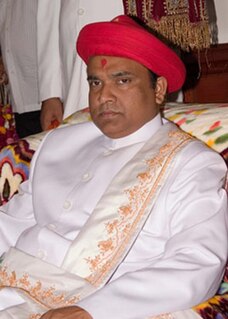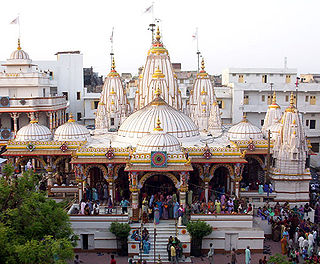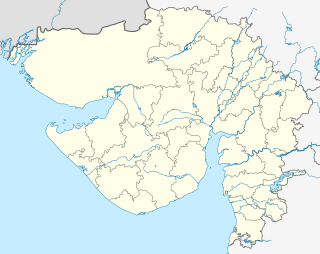
Bochasanwasi Akshar Purushottam Swaminarayan Sanstha (BAPS), is a Hindu denomination within the Swaminarayan Sampradaya. It was formed by Yagnapurushdas on the principle that Swaminarayan was to remain present on earth through a lineage of gurus dating all the way back to Gunatitanand Swami – one of Swaminarayan's most prominent disciples. Based on the Akshar Purushottam doctrine, followers of BAPS believe Swaminarayan manifests through a lineage of Aksharbrahman Gurus, beginning with Gunatitanand Swami, followed by Bhagatji Maharaj, Shastriji Maharaj, Yogiji Maharaj, Pramukh Swami Maharaj, and presently Mahant Swami Maharaj. As of 2019, BAPS has 44 shikharbaddha mandirs and more than 1,200 mandirs worldwide that facilitate practice of this doctrine by allowing followers to offer devotion to the murtis of Swaminarayan, Gunatitanand Swami, and their successors. BAPS mandirs also feature activities to foster culture and youth development. Many devotees view the mandir as a place for transmission of Hindu values and their incorporation into daily routines, family life, and careers. BAPS also engages in a host of humanitarian and charitable endeavors through BAPS Charities, a separate non-profit aid organization which has spearheaded a number of projects around the world addressing healthcare, education, environmental causes, and community-building campaigns.

Rakeshprasad is the disputed acharya of the LaxmiNarayan Dev Gadi of Swaminarayan Sampraday. An order by the Gujarat High Court restrained Ajendraprasad from acting as Acharya. This was a temporary order until the concluding court case. Ajendraprasad disputed this and filed a review petition in the Gujarat High Court. A satsang mahasabha headed by monks namely a Nautam Swami, self-appointed Rakeshprasad as acharya. Ajendraprasad main ideology was that monks of the fellowship should stay in their prescribed rules and regulations. Especially after some monks had turned towards murdering fellow monks. That the acharya at the time was firm and strong furied many monks to dispose of him.

Swaminarayan, also known as Sahajanand Swami, was a yogi and ascetic whose life and teachings brought a revival of central Hindu practices of dharma, ahimsa and brahmacarya. He is believed by followers to be a manifestation of God.

Yogiji Maharaj, born Jina Vasani, was a Hindu swami and the fourth spiritual successor of Swaminarayan in the Bochasanwasi Akshar Purushottam Swaminarayan Sanstha (BAPS), a major branch of the Swaminarayan Sampradaya. According to the metaphysics of BAPS, Yogiji Maharaj is considered to be the next iteration of Akshar after Shastriji Maharaj in the guru parampara, an unbroken line of "perfect devotees" who provide "authentication of office through Gunatitanand Swami and back to Swaminarayan himself." Together with Pramukh Swami Maharaj, who acted as the administrative head of BAPS, he was instrumental in nurturing the growth of BAPS "through new programs, expansion into new areas, and the construction of temples". As guru, he consecrated over 60 temples and visited over 4000 towns and villages. He was particularly effective in attracting the devotion of youths and initiated a large number of them as ascetics. Furthermore, his multiple tours to Britain and East Africa were integral in the overseas expansion of BAPS. He died on 23 January 1971 after appointing Pramukh Swami Maharaj as his successor.
The Laxminarayan Dev Gadi is one of the two gadis (diocese) that together form the Swaminarayan Sampraday. It is headquartered at the Shri Swaminarayan Mandir, Vadtal and controls the Dakshin Vibhag Lekh.
Nishkulanand Swami (1766–1848) was a Swaminarayan's paramhans and swami of the Swaminarayan Sampradaya.

Hinduism is a minority faith in Kenya, constituting 0.13% of the population of Kenya. Due to the encouragement of the Hindu Council of Kenya, Kenya is one of only three African countries to recognise Hinduism. Hindus are free to practise their religion in Kenya, and several Kenyan cities have Hindu temples. The Hindu temples in Kenya are mostly of north and west Indian architectural style.
BAPS Shri Swaminarayan Mandir, Nairobi is a Hindu temple in Nairobi, Kenya. Although there were temples in Africa before this, it is the first traditional stone and marble Hindu temple to be constructed on the African continent and was built by BAPS Swaminarayan Sanstha, a Hindu denomination within the Swaminarayan Sampradaya. It was opened on 29 August 1999 by Pramukh Swami Maharaj, the 5th spiritual leader of BAPS Swaminarayan Sanstha.

Shri Swaminarayan Mandir, Mumbai(Marathi: श्री स्वामीनारायण मंदिर, मुंबई) is a Hindu temple (Mandir) and a part of the Swaminarayan Sampraday. This Swaminarayan Temple is located in the Bhuleshwar area of Mumbai and is the oldest Swaminarayan Mandir in Mumbai, being over a hundred years old.

Shree Swaminarayan Mandir Kalupur is the first Temple of the Swaminarayan Sampraday, a Hindu sect. It is located in Kalupur area of Ahmedabad, the largest city in Gujarat, India. It was built on the instructions of Swaminarayan, the founder of the sect.

Shri Swaminarayan Mandir, Bhuj is a Hindu temple in Bhuj. This temple (mandir) that was constructed by Swaminarayan, founder of the Swaminarayan Sampraday.

Tejendraprasad Pande, formally known by his full title as Sanatan Dharma Dhurandar Acharya Maharaj Shree 1008 Tejendraprasadji Maharaj was appointed acharya of the Narnarayan Dev gadi (Ahmedabad) of the Swaminarayan Sampraday, a Hindu sect, by his father, the previous acharya, Devendraprasad, and was enthroned on 13 October 1969.

The Naranarāyan Dēv Gadī, named after NarNarayan Dev, is one of the two Gadis (seats) that together form the Swaminarayan Sampraday. Its headquarter is at the Shri Swaminarayan Mandir, Ahmedabad and controls the Uttar Vibhag.

The Swaminarayan Mandir in Weehawken, New Jersey is the first Swaminarayan temple of the Narnarayan Gadi in the United States. It is the national headquarters of the ISSO and comes under the NarNarayan Dev Gadi of the Swaminarayan Sampraday. Today there are four Swaminarayan temples in New Jersey alone.

Tarapur is a town in Tarapur Taluka in Anand district in the State of Gujarat, India. It is located on the Baroda – Rajkot Highway. It is the administrative seat for the taluka, a major trading centre of the Bhal region and gateway to the Charotar region.

Satsangi Jivan is the authorised biography of Swaminarayan. The book contains information on the life and teachings of Swaminarayan. It is written by Shatanand Swami and completed in 1829. Swaminarayan decided to make Gadhada his permanent residence on the insistence of Dada Khachar and his sisters. Upon completion of the Shri Swaminarayan Mandir, Gadhada in 1828, Swaminarayan instructed Shatanand Swami to write a book on his life and pastimes.
The International Swaminarayan Satsang Mandal (ISSM) is a religious organisation of the Hindu faith based in USA. It comes under the Shree Laxminarayan Dev Gadi of the Shree Swaminarayan Sampraday. The organisation has temples and centres in various parts of the country as well as a temple in Chicago, Illinois (America).

Shri Swaminarayan Temple, Wheeling is a Swaminarayan Hindu temple located in the Chicago suburb of Wheeling. It comes under the International Swaminarayan Satsang Mandal of the Swaminarayan Sampraday. The temple is also a member of the International Swaminarayan Satsang Organisation.

Shree Kutch Satsang Swaminarayan Temple (Bolton) is a three storied Swaminarayan Temple on Adelaide Street in Bolton, Greater Manchester, England. It is the first Swaminarayan temple to be established in the UK and Europe, officially opening in 1973. On 6 September 1973 a constitution was registered for the Temple under the Place of Worship Act, and on 6 September 1975 specially prepared murtis from the head Temple in Bhuj were installed in the Temple. The original structure was demolished and rebuilt in 1993. Prior to the new building a labour club and terraced houses were present on the temple site.
















